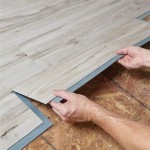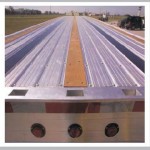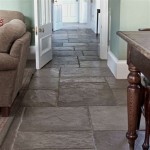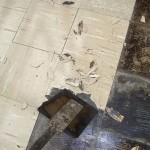Wood Floor Over Asbestos Tile: A Comprehensive Guide
Many older homes, particularly those constructed before the 1980s, contain asbestos-containing materials (ACMs). One common location for these materials is flooring, specifically vinyl asbestos tiles. Homeowners considering renovations, such as installing wood flooring, often encounter the question of whether they can install the new flooring directly over the existing asbestos tile. This article provides a comprehensive overview of the considerations, risks, and best practices associated with installing wood flooring over asbestos tile.
The presence of asbestos tiles in a home should not automatically trigger panic. Asbestos is generally considered safe when the fibers are tightly bound within a product and undisturbed. The primary concern arises when these materials are damaged or disturbed, releasing microscopic asbestos fibers into the air. Inhalation of these fibers over extended periods has been linked to serious health conditions, including asbestosis, lung cancer, and mesothelioma.
Therefore, any project involving asbestos-containing materials requires careful planning and adherence to safety guidelines. Whether the installation of a wood floor over asbestos tile is a safe and viable option depends on several crucial factors.
Key Point 1: Assessing the Condition of the Existing Asbestos Tile
The first and perhaps most critical step is to thoroughly assess the condition of the existing asbestos tile. A professional asbestos inspection is highly recommended. A qualified inspector can identify the presence of asbestos-containing materials, determine the type and concentration of asbestos present, and evaluate the overall condition of the tile. This assessment will inform the subsequent decisions regarding whether encapsulation (covering over the tile) is a suitable option.
Specifically, the assessment should focus on the following:
Integrity of the Tiles: Are the tiles intact, or are they cracked, broken, or crumbling? Damaged tiles are more likely to release asbestos fibers, making covering them more hazardous. If the tiles are significantly damaged, removal by a qualified asbestos abatement professional is often the safest course of action.
Adhesive Condition: The adhesive used to secure the tiles may also contain asbestos. The condition of the adhesive should be assessed alongside the tiles themselves. Loose or crumbling adhesive poses a similar risk to damaged tiles.
Levelness of the Floor: Is the existing tile floor relatively level? Significant unevenness will necessitate leveling measures before installing the wood floor. Grinding or sanding the asbestos tiles to level the floor is strongly discouraged, as this will invariably release asbestos fibers. Alternative leveling methods, such as self-leveling compounds applied over a suitable barrier, should be considered.
Presence of Moisture: Moisture can degrade the asbestos tile and adhesive, increasing the risk of fiber release. Furthermore, moisture issues can compromise the integrity of the new wood floor. Addressing any underlying moisture problems is essential before proceeding with the installation.
If the asbestos tiles are in good condition (intact, securely bonded, and relatively level) and there are no moisture issues, encapsulation might be a viable option. However, even with these conditions met, proper preparation and precautions are still necessary.
Key Point 2: Preparing the Surface for Wood Floor Installation
Assuming the assessment deems encapsulation a suitable option, the next step is to properly prepare the surface of the asbestos tile before installing the wood flooring. The primary goal is to create a barrier that prevents asbestos fiber release and provides a stable, level surface for the new flooring.
The following steps are typically involved in preparing the surface:
Cleaning: Thoroughly clean the existing asbestos tile floor to remove any dirt, debris, wax, or other contaminants. Use a mild detergent and water, avoiding harsh chemicals that could damage the tile. Allow the floor to dry completely.
Sealing (Optional but Recommended): Applying a sealant to the asbestos tile can further reduce the risk of fiber release. Choose a sealant specifically designed for use over asbestos-containing materials. Follow the manufacturer's instructions carefully.
Installing a Subfloor: A subfloor provides a stable and even surface for the wood flooring. The type of subfloor used will depend on the type of wood flooring being installed and the existing floor conditions. Plywood or oriented strand board (OSB) are common choices. Consider using a thicker subfloor material to create a more substantial barrier and improve the floor's overall rigidity.
Fastening the Subfloor: When fastening the subfloor to the existing floor, avoid penetrating the asbestos tiles as much as possible. Consider using construction adhesive to bond the subfloor to the tile. If nails or screws are necessary, use short fasteners and apply them sparingly, aiming for the grout lines between the tiles where possible. The goal is to avoid disturbing the asbestos tile as much as possible. If penetration is unavoidable, apply a small amount of sealant around the fastener to encapsulate any potential fiber release.
Installing a Moisture Barrier: A moisture barrier is crucial, even if the initial assessment didn't reveal any moisture problems. This barrier protects the wood flooring from moisture rising from the concrete slab or any residual moisture in the asbestos tile or adhesive. Polyethylene sheeting or a specialized underlayment with a built-in moisture barrier can be used.
Proper preparation is essential for a successful and safe installation. Skimping on these steps can increase the risk of asbestos fiber release and compromise the quality of the new wood floor.
Key Point 3: Understanding the Legal and Ethical Considerations
Beyond the practical aspects of installing wood flooring over asbestos tile, it is crucial to understand the legal and ethical considerations involved. Regulations regarding asbestos vary by location, so it is essential to consult with local and state authorities to ensure compliance.
Key Considerations include:
Disclosure: If selling the property in the future, it is generally necessary to disclose the presence of asbestos-containing materials to potential buyers. Failure to disclose could result in legal repercussions.
Permitting: Some jurisdictions require permits for projects involving asbestos-containing materials, even if the plan is to encapsulate rather than remove them. Check with the local building department to determine if a permit is required.
Professional Assistance: While it may be tempting to handle the project independently, engaging qualified professionals is strongly recommended. Asbestos abatement professionals can safely remove the asbestos tiles if encapsulation is not a viable option. Flooring installers with experience working with asbestos-containing materials can ensure the installation is done correctly and safely.
Worker Safety: If hiring contractors, verify that they are properly trained and equipped to work with asbestos-containing materials. They should use appropriate personal protective equipment (PPE), such as respirators and protective clothing, and follow established safety protocols.
Disposal: If any asbestos-containing materials are removed, they must be disposed of properly in accordance with local regulations. This typically involves sealing the materials in labeled containers and transporting them to a designated asbestos disposal facility.
Furthermore, there is an ethical consideration. While encapsulating asbestos tile might be permitted and even practical, it merely delays the responsibility of proper management. Future renovations or demolition may again raise the question of asbestos removal, potentially placing the burden and risks on future occupants or workers. A transparent and informed approach is crucial, prioritizes safety, and complies with all relevant regulations.
Choosing to install wood flooring over asbestos tile is a complex decision with potential health, legal, and ethical ramifications. A thorough assessment, careful preparation, and adherence to all applicable regulations are essential for ensuring a safe and successful project. Consulting with qualified professionals, including asbestos inspectors, abatement contractors, and flooring installers, is highly recommended to ensure the best possible outcome.

How To Install Hardwood Flooring Over Asbestos Tiles 123

Installing Hardwood Over Asbestos Tiles Homeadvisor

Flooring That Can Be Installed Over Asbestos Tile

Powder Room Floor Marmoleum Over Asbestos Tile

Let S Play A Game Called Are These Asbestos Tiles That I Just Removed Addicted 2 Decorating

Flooring That Can Be Installed Over Asbestos Tile

How To Seal Asbestos Tiles

How To Install Tile Over Asbestos Ehow

Can I Put A New Floor Over Asbestos Tiles Branch Environmental

Let S Play A Game Called Are These Asbestos Tiles That I Just Removed Addicted 2 Decorating
Related Posts








